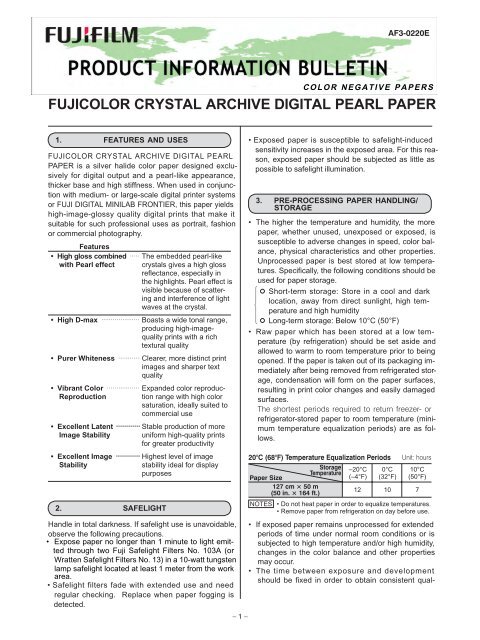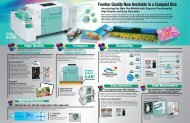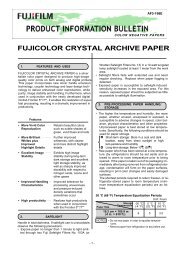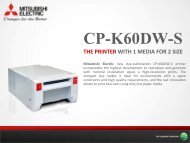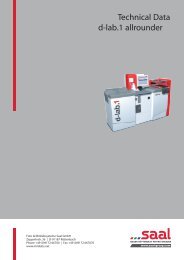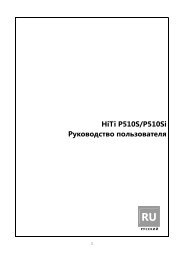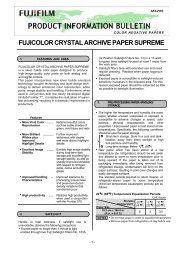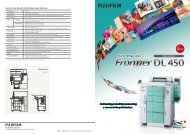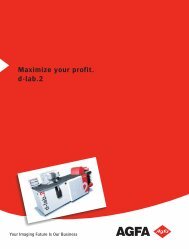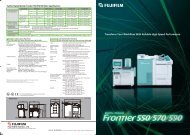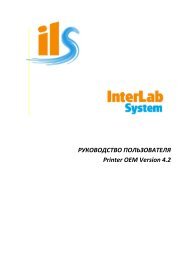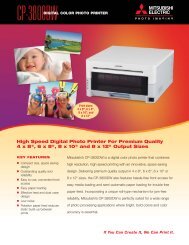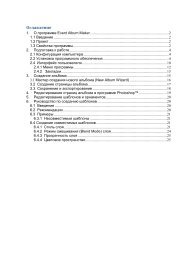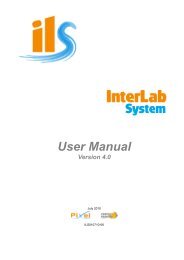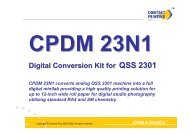FUJICOLOR CRYSTAL ARCHIVE DIGITAL PEARL PAPER
FUJICOLOR CRYSTAL ARCHIVE DIGITAL PEARL PAPER
FUJICOLOR CRYSTAL ARCHIVE DIGITAL PEARL PAPER
You also want an ePaper? Increase the reach of your titles
YUMPU automatically turns print PDFs into web optimized ePapers that Google loves.
<strong>FUJICOLOR</strong> <strong>CRYSTAL</strong> <strong>ARCHIVE</strong> <strong>DIGITAL</strong> <strong>PEARL</strong> <strong>PAPER</strong><br />
1. FEATURES AND USES<br />
<strong>FUJICOLOR</strong> <strong>CRYSTAL</strong> <strong>ARCHIVE</strong> <strong>DIGITAL</strong> <strong>PEARL</strong><br />
<strong>PAPER</strong> is a silver halide color paper designed exclusively<br />
for digital output and a pearl-like appearance,<br />
thicker base and high stiffness. When used in conjunction<br />
with medium- or large-scale digital printer systems<br />
or FUJI <strong>DIGITAL</strong> MINILAB FRONTIER, this paper yields<br />
high-image-glossy quality digital prints that make it<br />
suitable for such professional uses as portrait, fashion<br />
or commercial photography.<br />
Features<br />
• High gloss combined ..... The embedded pearl-like<br />
with Pearl effect crystals gives a high gloss<br />
reflectance, especially in<br />
the highlights. Pearl effect is<br />
visible because of scattering<br />
and interference of light<br />
waves at the crystal.<br />
High D-max .................... Boasts a wide tonal range,<br />
producing high-imagequality<br />
prints with a rich<br />
textural quality<br />
Purer Whiteness ........... Clearer, more distinct print<br />
images and sharper text<br />
quality<br />
Vibrant Color .................<br />
Reproduction<br />
Expanded color reproduction<br />
range with high color<br />
saturation, ideally suited to<br />
commercial use<br />
Excellent Latent ............ Stable production of more<br />
Image Stability uniform high-quality prints<br />
for greater productivity<br />
Excellent Image ............ Highest level of image<br />
Stability<br />
stability ideal for display<br />
purposes<br />
2. SAFELIGHT<br />
Handle in total darkness. If safelight use is unavoidable,<br />
observe the following precautions.<br />
Expose paper no longer than 1 minute to light emitted<br />
through two Fuji Safelight Filters No. 103A (or<br />
Wratten Safelight Filters No. 13) in a 10-watt tungsten<br />
lamp safelight located at least 1 meter from the work<br />
area.<br />
• Safelight filters fade with extended use and need<br />
regular checking. Replace when paper fogging is<br />
detected.<br />
– 1 –<br />
Exposed paper is susceptible to safelight-induced<br />
sensitivity increases in the exposed area. For this reason,<br />
exposed paper should be subjected as little as<br />
possible to safelight illumination.<br />
3. PRE-PROCESSING <strong>PAPER</strong> HANDLING/<br />
STORAGE<br />
The higher the temperature and humidity, the more<br />
paper, whether unused, unexposed or exposed, is<br />
susceptible to adverse changes in speed, color balance,<br />
physical characteristics and other properties.<br />
Unprocessed paper is best stored at low temperatures.<br />
Specifically, the following conditions should be<br />
used for paper storage.<br />
Short-term storage: Store in a cool and dark<br />
location, away from direct sunlight, high tem-<br />
<br />
perature and high humidity<br />
Long-term storage: Below 10°C (50°F)<br />
Raw paper which has been stored at a low temperature<br />
(by refrigeration) should be set aside and<br />
allowed to warm to room temperature prior to being<br />
opened. If the paper is taken out of its packaging immediately<br />
after being removed from refrigerated storage,<br />
condensation will form on the paper surfaces,<br />
resulting in print color changes and easily damaged<br />
surfaces.<br />
The shortest periods required to return freezer- or<br />
refrigerator-stored paper to room temperature (minimum<br />
temperature equalization periods) are as follows.<br />
20°C (68°F) Temperature Equalization Periods Unit: hours<br />
Paper Size<br />
Storage<br />
Temperature<br />
–20°C<br />
(–4°F)<br />
0°C<br />
(32°F)<br />
AF3-0220E<br />
COLOR NEGATIVE <strong>PAPER</strong>S<br />
10°C<br />
(50°F)<br />
127 cm × 50 m<br />
(50 in. × 164 ft.)<br />
12 10 7<br />
NOTES Do not heat paper in order to equalize temperatures.<br />
Remove paper from refrigeration on day before use.<br />
If exposed paper remains unprocessed for extended<br />
periods of time under normal room conditions or is<br />
subjected to high temperature and/or high humidity,<br />
changes in the color balance and other properties<br />
may occur.<br />
The time between exposure and development<br />
should be fixed in order to obtain consistent qual-
FUJIFILM PRODUCT INFORMATION BULLETIN • <strong>FUJICOLOR</strong> <strong>CRYSTAL</strong> <strong>ARCHIVE</strong> <strong>DIGITAL</strong> <strong>PEARL</strong> <strong>PAPER</strong><br />
ity. Avoid waiting until the next day to develop the<br />
exposed paper. Rather than holding the paper for<br />
processing the next day, initiate processing as soon<br />
as possible.<br />
4. CALIBRATION DATA FOR PRINTERS<br />
Please refer to the following calibration data as a general<br />
guide when using <strong>FUJICOLOR</strong> <strong>CRYSTAL</strong> <strong>ARCHIVE</strong><br />
<strong>DIGITAL</strong> <strong>PEARL</strong> <strong>PAPER</strong> on a digital printer.<br />
1. Frontier 350/355/370/375/390/550/570/590<br />
<strong>FUJICOLOR</strong> <strong>CRYSTAL</strong> <strong>ARCHIVE</strong> <strong>DIGITAL</strong> <strong>PEARL</strong><br />
<strong>PAPER</strong> requires dedicated LUT which is available<br />
on installer A3 version R. For availability of this CD,<br />
please contact your local distributor.<br />
The Pearl paper not recommended for Frontier 500.<br />
<br />
1 Make sure the printer version number in the main<br />
menu ends with an “r” or some higher letter.<br />
2 Log in to the “4 Setup and Maintenance” menu with<br />
“SE2” for the user name, and a password of “7777”.<br />
3 Select “5 Printer Adjustment/Maintenance” – “1 Paper<br />
Magazine Registration” (Menu 451) and change<br />
the paper type to “A” as shown in the table below.<br />
Paper Type Surface<br />
<strong>CRYSTAL</strong> <strong>ARCHIVE</strong> <strong>DIGITAL</strong><br />
<strong>PEARL</strong> <strong>PAPER</strong><br />
A other 2<br />
4 Select “2 Print Condition Setup and Check” – “1 Paper<br />
Condition Setup” (Menu 421) and perform a paper<br />
condition setup for all magazines for which the<br />
paper types were changed.<br />
FUJIFILM PRODUCT INFORMATION BULLETIN • <strong>FUJICOLOR</strong> <strong>CRYSTAL</strong> <strong>ARCHIVE</strong> <strong>DIGITAL</strong> <strong>PEARL</strong> <strong>PAPER</strong><br />
Epsilon 30 plus<br />
Dmax Aim Basic Calibration* Intermittency<br />
R = 2.35 Y = 0.004 R = 90<br />
G = 2.35 M = 0.056 G = 50<br />
B = 2.25 C = 0.000 B = 37<br />
D = 0.920<br />
* If a DPII set-up is already used on the machine, please use<br />
the current DPII set-up as starting values instead of values<br />
above.<br />
3. Polielettronica Laserlab 50/76/127 Reference Data<br />
Use the auto calibration tools as is in the machine.<br />
This will calibrate <strong>FUJICOLOR</strong> <strong>CRYSTAL</strong> <strong>ARCHIVE</strong><br />
<strong>DIGITAL</strong> <strong>PEARL</strong> <strong>PAPER</strong> to Dmax 2.35/2.35/2.25<br />
(R/G/B).<br />
4. Oce LightJet Reference Data<br />
Same calibration routine as for Fujicolor Crystal<br />
Archive Type DPII can be used<br />
The calibration targets for the OCE Lightjet 430,<br />
500XL and 5000 printers can be downloaded from<br />
the following URLs (websites). http://www.oce-dgs.com/<br />
PrinterSupport/LJ_Customer_Access/Media_Targets/<br />
LJ5000_MediaTargets.htm<br />
5. Konica R1/R2/R3 supert Reference Data<br />
Give paper cassette unique product code and follow<br />
standards set-up routine as describe in the Konica<br />
Manual.<br />
6. Noritsu Reference Data<br />
Paper profile needs adjustment.Profile data is avail-<br />
able via your local Noritsu distributor or you can<br />
contact technicalsupport@fujifilm.eu<br />
7. Agfa d-Lab Reference Data<br />
Manual is available on request via<br />
technicalsupport@fujifilm.eu<br />
8. Optical printing<br />
It is not recommended to use <strong>FUJICOLOR</strong> <strong>CRYSTAL</strong><br />
<strong>ARCHIVE</strong> <strong>DIGITAL</strong> <strong>PEARL</strong> <strong>PAPER</strong> for optical / analogue<br />
printing.<br />
5. PROCESSING<br />
This paper is designed for use with Fuji Hunt CP-RA<br />
Process, Fuji MINILAB Process CP-49E/CP-48S or RA-4<br />
type processes.<br />
– 3 –<br />
6. POST-PROCESSING <strong>PAPER</strong> (PRINT)<br />
HANDLING/STORAGE<br />
Prints are subjected to various influences (heat, humidity,<br />
light, air pollution, etc.) relative to the conditions under<br />
which they are stored.<br />
The general conditions under which prints are stored<br />
are outlined below.<br />
<br />
<br />
<br />
<br />
<br />
<br />
<br />
<br />
<br />
Recommended Storage Conditions:<br />
Temperature: Below 25°C (77°F)<br />
Humidity: 30% to 50% RH with good ventilation<br />
Extended Storage Conditions:<br />
Temperature: Below 10°C (50°F)<br />
Humidity: 30% to 50% RH<br />
7. LIGHT SOURCES FOR VIEWING<br />
When inspecting finished color prints, it is essential that<br />
an illumination source be used that has superior spectral<br />
characteristics, adequately high color temperature<br />
and sufficient brightness. This is because results can<br />
appear different, depending on light quality. For precise<br />
results, prints should be examined under the conditions<br />
designated by ISO 3664-2000. As a general guide, the<br />
following conditions are recommended.<br />
Color Temperature : 5000 ± 300 K<br />
Average Illumination : 500 Lux or more<br />
General Color Rendering Index : Ra 90 or more*<br />
* To attain these values, special fluorescent lamps designed for<br />
color evaluation (e.g. EDL type) should be used.<br />
When inspecting finished prints, be careful to shut out<br />
all external light and colored reflected light.<br />
Best pearl effect will be visible when using scattering<br />
light.<br />
8. MOUNTING and LAMINATION<br />
In order to maintain the high quality pearl and gloss<br />
effect we advise to mount <strong>FUJICOLOR</strong> <strong>CRYSTAL</strong><br />
<strong>ARCHIVE</strong> <strong>DIGITAL</strong> <strong>PEARL</strong> <strong>PAPER</strong> only on very smooth<br />
carrier. Also we advise to use no lamination. If due to<br />
exhibition circumstances lamination is necessary, a<br />
high gloss lamination is best when you want to maintain<br />
the level of reflectance. However special sparkling<br />
effect are possible when using matte lamination or<br />
front-side mounting of arcrylic. Please consult your<br />
mounting and lamination specialist for best results.
FUJIFILM PRODUCT INFORMATION BULLETIN<br />
9. <strong>PAPER</strong> SURFACES AVAILABLE<br />
<strong>FUJICOLOR</strong> <strong>CRYSTAL</strong> <strong>ARCHIVE</strong> <strong>DIGITAL</strong> <strong>PEARL</strong><br />
<strong>PAPER</strong> is only available in glossy surface.<br />
10. SIZES AVAILABLE<br />
Rolls<br />
Length<br />
Width<br />
12.7 cm<br />
15.2 cm<br />
17.8 cm<br />
20.3 cm<br />
25.4 cm<br />
30.5 cm<br />
50.8 cm<br />
76.2 cm<br />
106 cm<br />
127 cm<br />
50 m 75 m 150 m<br />
11. CONTROL STRIPS<br />
Processing control can be provided through the use of<br />
<strong>FUJICOLOR</strong> <strong>CRYSTAL</strong> <strong>ARCHIVE</strong> <strong>PAPER</strong> Control Strips<br />
- Process CP-40FA/43FA/47L/48S/49E.<br />
12. MARKINGS (BOX/EMULSION NUMBERS)<br />
12-1 Box Markings<br />
12-2 Bag Labeling<br />
12-3 Emulsion Numbers<br />
Emulsion numbering will range between F01-F99.<br />
•<br />
<strong>FUJICOLOR</strong> <strong>CRYSTAL</strong> <strong>ARCHIVE</strong> <strong>DIGITAL</strong> <strong>PEARL</strong> <strong>PAPER</strong><br />
– 4 –<br />
13. Backprinting<br />
<strong>FUJICOLOR</strong> <strong>CRYSTAL</strong> <strong>ARCHIVE</strong> <strong>DIGITAL</strong> <strong>PEARL</strong><br />
<strong>PAPER</strong> is only available without backprinting.<br />
14. TECHNOLOGIES INCORPORATED IN<br />
THIS <strong>PAPER</strong><br />
14-1 Fujifilm Pearl Technology<br />
This photographic paper contains a very special type<br />
of pigment: pearl mica pigments. Based on the natural<br />
mica, they are covered with a thin layer of metal oxides,<br />
for example titanium dioxide. Through an interplay of<br />
transparency, refraction, coating and multiple reflections,<br />
you will see silver-white, and metallic reflectance<br />
effects. This will lend your pictures a new warmth and<br />
depth.<br />
The Fujifilm Pearl technology does not affect the physical<br />
properties like paper cutting.<br />
14-2 X-Coupler Technology<br />
Through the incorporation of a new cyan coupler (X-<br />
Coupler Technology) used in <strong>FUJICOLOR</strong> <strong>CRYSTAL</strong><br />
<strong>ARCHIVE</strong> <strong>DIGITAL</strong> <strong>PEARL</strong>, this photographic paper<br />
is capable of reproducing the subtle shades of green<br />
and of forming colors of high purity, such as vibrant<br />
blues and reds.<br />
14-3 NLS (New Low Stain Spectral-Sensitizer)<br />
Technology and ARR (Advanced Resistance-<br />
to-Radiation) Technology<br />
Through the incorporation of NLS Technology and ARR<br />
Technology used in <strong>FUJICOLOR</strong> <strong>CRYSTAL</strong> <strong>ARCHIVE</strong><br />
<strong>DIGITAL</strong> <strong>PEARL</strong><strong>PAPER</strong> , this photographic paper is<br />
more brilliant, purer whites and clearer and more distinct<br />
highlights, and has been incorporated to suppress<br />
color paper fogging caused by ambient radiation, enhancing<br />
the maintenance of white purity in unexposed<br />
color paper.
FUJIFILM PRODUCT INFORMATION BULLETIN • <strong>FUJICOLOR</strong> <strong>CRYSTAL</strong> <strong>ARCHIVE</strong> <strong>DIGITAL</strong> <strong>PEARL</strong> <strong>PAPER</strong><br />
Density<br />
15. CHARACTERISTIC CURVES<br />
4.0<br />
3.5<br />
3.0<br />
2.5<br />
2.0<br />
1.5<br />
1.0<br />
0.5<br />
0.0<br />
Spectral Reflection Density<br />
Exposure :Laser Exposure<br />
Process :CP-48S<br />
Densitometry :Status A<br />
R<br />
G<br />
B<br />
0.5<br />
Relative log H (lux-seconds)<br />
17. SPECTRAL DYE DENSITY CURVES<br />
1.0<br />
0.5<br />
0.0<br />
Yellow Magenta Cyan<br />
Process:CP-48S<br />
400 500 600 700<br />
Wavelength (nm)<br />
– 5 –<br />
Relative Sensitivity*<br />
1.0<br />
16. SPECTRAL SENSITIVITY CURVES<br />
Blue<br />
Sensitive<br />
Layer<br />
Green<br />
Sensitive<br />
Layer<br />
Process :CP-48S<br />
Densitometry :Status A<br />
Density :1.0 above Dmin<br />
Red<br />
Sensitive<br />
Layer<br />
400 500 600 700<br />
Wavelength (nm)<br />
* Sensitivity equals the reciprocal of the exposure<br />
(J/cm 2 ) required to produce a specified density.
Density (D)<br />
FUJIFILM PRODUCT INFORMATION BULLETIN <strong>FUJICOLOR</strong> <strong>CRYSTAL</strong> <strong>ARCHIVE</strong> <strong>DIGITAL</strong> <strong>PEARL</strong> <strong>PAPER</strong><br />
1.0<br />
0.9<br />
0.8<br />
0.7<br />
0.6<br />
18. IMAGE STORAGE CHARACTERISTICS<br />
Estimated Dark Storage Stability at 25°C (77°F) Estimated Light Storage Stability under 500 Lux<br />
Intermittent Illumination Conditions***<br />
Color Dye Fading*<br />
( Color Patch at Density of 1.0)<br />
Recomended Long-term Storage<br />
Condition** (40% RH)<br />
High Humidity Storage<br />
Condition** (70% RH)<br />
Stain*<br />
Process: CP-48S<br />
CC Y M Y M<br />
1 2 5 10 20 50 100 200 500 1000<br />
Years (log scale)<br />
0.6<br />
0.5<br />
0.4<br />
0.3<br />
0.2<br />
0.1<br />
Density (ΔDB)<br />
Density (D)<br />
Color Dye Fading*<br />
(Color Patch at Density of 1.0)<br />
Stain*<br />
5 10<br />
Years<br />
Average light exposure:<br />
500 Lux, 12 hours/day***<br />
Process: CP-48S<br />
* Time-induced white background staining (yellowing) is as important as dye image fading in affecting image quality.<br />
** In regard to color image dark storage stability, the level of humidity is just as important as temperature. For this reason, more accurate<br />
evaluations can be made by using the two humidity standards --- one for high humidity storage conditions (70%RH) and that recommended<br />
for long term storage (40%RH).<br />
*** Since in common domestic situations sunlit areas may be bright as 1,000 lux or more during the day and drop to 300 lux in the evening and at<br />
night, storage conditions are usually designated to be at an average of 500 lux of light exposure for 12 hours per day.<br />
19. Paper structure<br />
Protective Layer<br />
Red Sensitive Layer<br />
(Containing Colorless Cyan Coupler)<br />
Interlayer<br />
Green Sensitive Layer<br />
(Containing Colorless Magenta Coupler)<br />
Interlayer<br />
Blue Sensitive Layer<br />
(Containing Colorless Yellow Coupler)<br />
Resin-coated Paper<br />
1.0<br />
0.9<br />
0.8<br />
0.7<br />
0.6<br />
Before<br />
Processing After<br />
Processing<br />
Cyan Dye Image<br />
Magenta Dye Image<br />
Yellow Dye Image<br />
Pearl mica pigment<br />
: Silver Halide<br />
: Coupler<br />
: Processing-induced Dye<br />
NOTICE The data herein published were derived from materials taken from<br />
general production runs. However, changes in specifications may occur<br />
without notice.<br />
7-3, Akasaka 9-chome, Minato-ku, Tokyo 107-0052, Japan<br />
15<br />
M<br />
Y<br />
C<br />
0.2<br />
0.1<br />
0.0<br />
Density (ΔDB)<br />
Ref. No. AF3-220E (updated FFME 12-2008)


